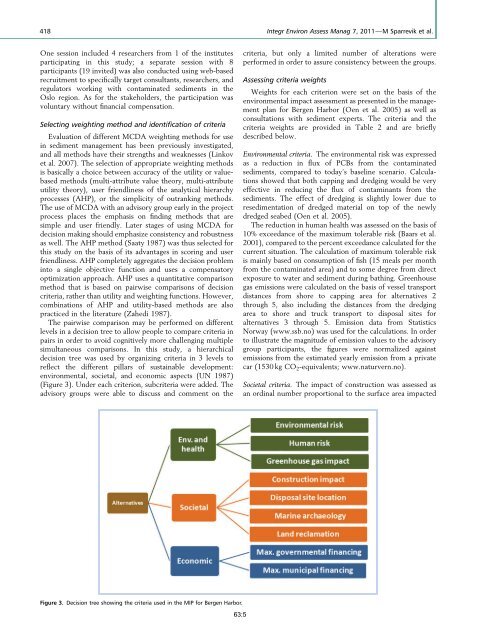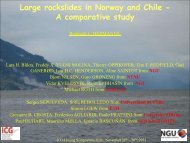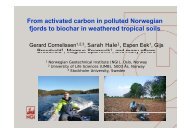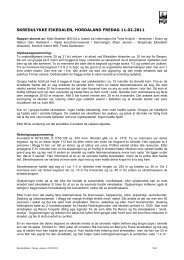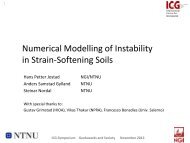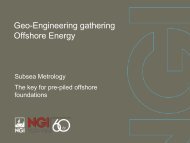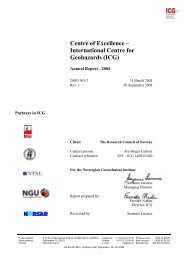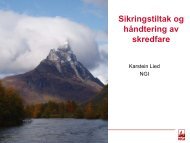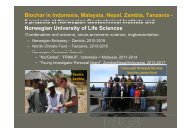fulltext - DiVA
fulltext - DiVA
fulltext - DiVA
Create successful ePaper yourself
Turn your PDF publications into a flip-book with our unique Google optimized e-Paper software.
418 Integr Environ Assess Manag 7, 2011—M Sparrevik et al.One session included 4 researchers from 1 of the institutesparticipating in this study; a separate session with 8participants (19 invited) was also conducted using web-basedrecruitment to specifically target consultants, researchers, andregulators working with contaminated sediments in theOslo region. As for the stakeholders, the participation wasvoluntary without financial compensation.Selecting weighting method and identification of criteriaEvaluation of different MCDA weighting methods for usein sediment management has been previously investigated,and all methods have their strengths and weaknesses (Linkovet al. 2007). The selection of appropriate weighting methodsis basically a choice between accuracy of the utility or valuebasedmethods (multi-attribute value theory, multi-attributeutility theory), user friendliness of the analytical hierarchyprocesses (AHP), or the simplicity of outranking methods.The use of MCDA with an advisory group early in the projectprocess places the emphasis on finding methods that aresimple and user friendly. Later stages of using MCDA fordecision making should emphasize consistency and robustnessas well. The AHP method (Saaty 1987) was thus selected forthis study on the basis of its advantages in scoring and userfriendliness. AHP completely aggregates the decision probleminto a single objective function and uses a compensatoryoptimization approach. AHP uses a quantitative comparisonmethod that is based on pairwise comparisons of decisioncriteria, rather than utility and weighting functions. However,combinations of AHP and utility-based methods are alsopracticed in the literature (Zahedi 1987).The pairwise comparison may be performed on differentlevels in a decision tree to allow people to compare criteria inpairs in order to avoid cognitively more challenging multiplesimultaneous comparisons. In this study, a hierarchicaldecision tree was used by organizing criteria in 3 levels toreflect the different pillars of sustainable development:environmental, societal, and economic aspects (UN 1987)(Figure 3). Under each criterion, subcriteria were added. Theadvisory groups were able to discuss and comment on thecriteria, but only a limited number of alterations wereperformed in order to assure consistency between the groups.Assessing criteria weightsWeights for each criterion were set on the basis of theenvironmental impact assessment as presented in the managementplan for Bergen Harbor (Oen et al. 2005) as well asconsultations with sediment experts. The criteria and thecriteria weights are provided in Table 2 and are brieflydescribed below.Environmental criteria. The environmental risk was expressedas a reduction in flux of PCBs from the contaminatedsediments, compared to today’s baseline scenario. Calculationsshowed that both capping and dredging would be veryeffective in reducing the flux of contaminants from thesediments. The effect of dredging is slightly lower due toresedimentation of dredged material on top of the newlydredged seabed (Oen et al. 2005).The reduction in human health was assessed on the basis of10% exceedance of the maximum tolerable risk (Baars et al.2001), compared to the percent exceedance calculated for thecurrent situation. The calculation of maximum tolerable riskis mainly based on consumption of fish (15 meals per monthfrom the contaminated area) and to some degree from directexposure to water and sediment during bathing. Greenhousegas emissions were calculated on the basis of vessel transportdistances from shore to capping area for alternatives 2through 5, also including the distances from the dredgingarea to shore and truck transport to disposal sites foralternatives 3 through 5. Emission data from StatisticsNorway (www.ssb.no) was used for the calculations. In orderto illustrate the magnitude of emission values to the advisorygroup participants, the figures were normalized againstemissions from the estimated yearly emission from a privatecar (1530 kg CO 2 -equivalents; www.naturvern.no).Societal criteria. The impact of construction was assessed asan ordinal number proportional to the surface area impactedFigure 3. Decision tree showing the criteria used in the MIP for Bergen Harbor.63:5


